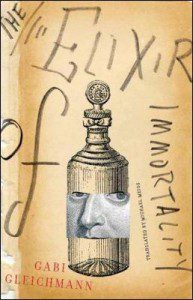
Whether we’re talking about the crime novels of Stieg Larsson and Henning Mankell or the popular literary fare of Jonas Jonasson and Per Petterson, Scandinivian fiction burns hotter than the midnight sun these days. Oslo journalist Gabi Gleichmann’s novel The Elixir of Immortality is the latest debut from Northern Europe with international bestselling aspirations. Spanning nearly 800 pages and 900 years, The Elixir of Immortality is an entertaining pan-European epic, an extended family saga that will have you flipping back to the family tree diagram at the front of the book while searching Wikipedia to brush up on your European history.
Ari Spinoza is terminally ill and the last of his family line. Muted by cancer of the larynx, he conjures his family story, which starts in the twelfth century and loosely parallels the Biblical legend of The Wandering Jew. Multiple generations of Spinozas wander Europe in exile thanks to various incidents of anti-Semitism. Defeat and tragedy target Spinozas with large noses, blessing them with high achievement and cursing them with cartoonish deaths. Our protagonists die of fallen chandeliers, dropping Talmuds, and even plummeting airplane wheels. Inspired by his great-uncle’s love of storytelling, Ari prepares the reader for an adventure of extremes, one that will sparkle with magic even as it’s underpinned by suffering:
By making unusual things seem ordinary and ordinary things appear unusual, by embellishing the ugly and making the fleeting moment eternal, my great-uncle taught us at an early age that there is hope even in the worst situations; life is always worth living, if only because it is so painfully brief. He created a parallel universe for us, one charged with suffering and mystery to shield us against perverse reality and the endless possibilities of defeat.
In the 1600s, Benjamin Spinoza, a philosopher, becomes obsessed with the existence of a recipe for eternal life created by his grandfather Baruch, who was visited by Moses, the prophet of the Jews himself. Benjamin pens a mystical manuscript entitled The Elixir of Immortality that he passes down from generation to generation. It eventually lands in the possession of Ari. The contents of the book are never revealed and we’re left to take the word of one Spinoza after another that this book-within-a-book is magnificent and bears the secret to eternal life.

Ari’s narration is the flab in this already hefty volume. His repetitive premise-setting detracts from the brightness and fun of the historical celebrity cameos. The Spinozas become involved with Freud, Voltaire, Napoleon, and countless others. There were so many cameos that I began Googling names to see which ones of Gleichmann’s minor characters were actual historical figures. In the following passage, Ari’s great-uncle’s interest in chess brings him in contact with a couple of famous Marxists in Vienna:
Trotsky came every Wednesday to seek company and was valued by everyone for his elaborate politeness and his admirable conversational gifts. But his guest, dressed in heavy dirty boots and a ragged overcoat, had the manners of a real peasant and was incapable of polite conversation. On the other hand, he was a remarkable chess player, at his best in the middle game where he had mastered a great variety of clever and complicated moves. Forceful attacks on the king were his specialty, and his opponents rarely survived them. He moved the pieces with his left hand even though it was somewhat withered. He made short work of everyone in the tavern.
Trotsky called him ‘Koba.’ Some say that his real name was Josef Dzhugashvili. Others used his nickname: Stalin.
While some of the celebrity cameos are only meant to amuse, others cast the Spinozas as quiet actors in history. After Nicholas Spinoza is sent to the guillotine by his best friend Robespierre during the French Revolution, his wife Chiara pens a novel about the tragedy that eventually lands in the hands of Francisco Goya, the Spanish romantic painter. Goya becomes obsessed and inspired by the work’s darkness, which leads to the creation of one of his famous works.
Goya opened the novel at random and began reading, not without an occasional yawn, until he came to the passage that describes how the coldhearted revolutionary leader sends his best friend to the guillotine… Fascinated, he paged farther. At last, eighteen hours later, he put down the bulky novel. He was deeply affected. For three days he found it impossible to eat, drink, or sleep… He picked up the broadest of his paintbrushes and a container of black oil paint. He looked around for a canvas that would be large enough… This was the beginning of the ‘black period’ in his art… The completed work shows a gigantic monster that has just chewed off the head of a naked male body held in its hands. Goya named it after Chiara’s novel…Saturno devorando a su hijo (‘Saturn devouring his child’) is one of the artist’s greatest masterpieces.
The repeated and somewhat blunt appearances of anti-Semitic persecution in The Elixir of Immortality give this light fable some much-needed weight. After retelling the story of watching a boy get murdered by the Germans, Ari’s dying mother asks her son, “How could God let that happen? You have to tell it to everyone.” Her question and command are greater catalysts for this book’s existence than any recipe for immortality.
After flying over the Middle Ages, the Renaissance, the Age of Enlightenment, the French Revolution, two world wars and The Holocaust, and the rise of communism, I did wish for a more profound destination, but The Elixir of Immortality works as an amusing panorama of European history through the many eyes of one prodigious Jewish family.




